CURRENCIES
WEAPONS
ITEMS
VEHICLES
CONSUMABLES
HOME
Since the collapse of the old Creator Empire, a number of economies have sprung up among the surviving races. Most of these revolve around precious stones or metals, though many of the more primitive cultures still exchange raw goods and materials in a bartering-style exhange. The most powerful economic infrastructure is controlled by the gorgs, who design fantastic currencies, banks, and lending systems. Other, more mundane currencies are still found among the outlying regions of Haun, Arthandur, and even the shores of Freilu, though these aren't worth much elsewhere.
ERDANI COINS (Gorgish)
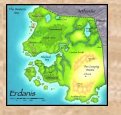 Erdani coins are second only to Tamaran gears in artistic design, and for good reason. The gorgs who mint them have discovered that by creating currency that is highly pleasing to the eye, they increase the lengths to which people will go to get it. Ordinary gold may glitter, but when mixed with certain patterns of jewels and fine etching, coins become even more coveted. This mild greed-enhancement drives up the economy, giving it a much stronger hold over society than within non-plutocratic systems. The gorgs are also very traditional in their currency design - unusual shapes and colors aside, they insist that the value of each coin be self-backing, and thus universally appealing to those who might not otherwise recognize the coin of other realms. They are surprisingly durable and nearly impossible to counterfeit, the product of a culture obsessed with the sacred qualities of wealth and materialism. The triangular shape is designed for efficient stacking - coins of similar value can be stacked end-to-end into a container such as a chest with no wasted space whatsoever. It also keeps them from rolling away when spilled, and makes coin-shaving blatantly obvious.
Erdani coins are second only to Tamaran gears in artistic design, and for good reason. The gorgs who mint them have discovered that by creating currency that is highly pleasing to the eye, they increase the lengths to which people will go to get it. Ordinary gold may glitter, but when mixed with certain patterns of jewels and fine etching, coins become even more coveted. This mild greed-enhancement drives up the economy, giving it a much stronger hold over society than within non-plutocratic systems. The gorgs are also very traditional in their currency design - unusual shapes and colors aside, they insist that the value of each coin be self-backing, and thus universally appealing to those who might not otherwise recognize the coin of other realms. They are surprisingly durable and nearly impossible to counterfeit, the product of a culture obsessed with the sacred qualities of wealth and materialism. The triangular shape is designed for efficient stacking - coins of similar value can be stacked end-to-end into a container such as a chest with no wasted space whatsoever. It also keeps them from rolling away when spilled, and makes coin-shaving blatantly obvious.
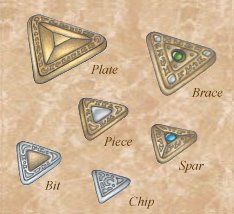
Plate (Solid Gold):
Brace (Gold, Jade):
Spar (Gold, Turquoise):
Piece (Gold, Quartz):
Bit (Bronze, Silver):
Chip (Nickel, Silver):
|
|
50 Coin
10 Coin
5 Coin
1 Coin
1/10 Coin
1/100 Coin
The Erdani plate and brace are generally used only by merchants who must exchange large quantities of liquid assets at minimal cost and counting. Few common folk have need for coins in these denominations. The middler classes make use of the more common spar and piece, which contain less gold and lower quality gemstones made un-pryable by their smooth, cabochon design. These coins are the backbone of the Erdani economic structure, generally used to purchase goods such as armor, equipment, livestock, and so forth. Finally, there are the lower value coins, the silver bit, and the nickel chip. These are the disposable wages of the common folk, used to purchase food and drink, to tip stable boys, or rent average quality rooms at an inn. Chips have become so low-valued, in fact, as to be considered 'garbage' currency by all but the most needy of folk. They are consequently the only type of coin Erdani slaves are permitted to carry.
ARTHANDURIAN RODS (Elven)
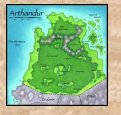 Erdani coins are second only to Tamaran gears in artistic design, and for good reason. The gorgs who mint them have discovered that by creating currency that is highly pleasing to the eye, they increase the lengths to which people will go to get it. Ordinary gold may glitter, but when mixed with certain patterns of jewels and fine etching, coins become even more coveted. This mild greed-enhancement drives up the economy, giving it a much stronger hold over society than within non-plutocratic systems. The gorgs are also very traditional in their currency design - unusual shapes and colors aside, they insist that the value of each coin be self-backing, and thus universally appealing to those who might not otherwise recognize the coin of other realms. They are surprisingly durable and nearly impossible to counterfeit, the product of a culture obsessed with the sacred qualities of wealth and materialism. The triangular shape is designed for efficient stacking - coins of similar value can be stacked end-to-end into a container such as a chest with no wasted space whatsoever. It also keeps them from rolling away when spilled, and makes coin-shaving blatantly obvious.
Erdani coins are second only to Tamaran gears in artistic design, and for good reason. The gorgs who mint them have discovered that by creating currency that is highly pleasing to the eye, they increase the lengths to which people will go to get it. Ordinary gold may glitter, but when mixed with certain patterns of jewels and fine etching, coins become even more coveted. This mild greed-enhancement drives up the economy, giving it a much stronger hold over society than within non-plutocratic systems. The gorgs are also very traditional in their currency design - unusual shapes and colors aside, they insist that the value of each coin be self-backing, and thus universally appealing to those who might not otherwise recognize the coin of other realms. They are surprisingly durable and nearly impossible to counterfeit, the product of a culture obsessed with the sacred qualities of wealth and materialism. The triangular shape is designed for efficient stacking - coins of similar value can be stacked end-to-end into a container such as a chest with no wasted space whatsoever. It also keeps them from rolling away when spilled, and makes coin-shaving blatantly obvious.
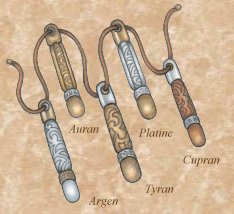
Tyran (Fine Gold):
Platine (Gold, Platinum):
Auran (Gold):
Argen (Silver):
Cupran (Copper, Nickel):
|
|
50 Coin
10 Coin
1 Coin
1/10 Coin
1/100 Coin
The Erdani plate and brace are generally used only by merchants who must exchange large quantities of liquid assets at minimal cost and counting. Few common folk have need for coins in these denominations. The middler classes make use of the more common spar and piece, which contain less gold and lower quality gemstones made un-pryable by their smooth, cabochon design. These coins are the backbone of the Erdani economic structure, generally used to purchase goods such as armor, equipment, livestock, and so forth. Finally, there are the lower value coins, the silver bit, and the nickel chip. These are the disposable wages of the common folk, used to purchase food and drink, to tip stable boys, or rent average quality rooms at an inn. Chips have become so low-valued, in fact, as to be considered 'garbage' currency by all but the most needy of folk. They are consequently the only type of coin Erdani slaves are permitted to carry.
TAMARAN GEARS (Gorgish)
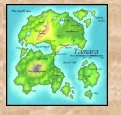 It's important to mention here that prices are a little steep in Tamara. After all, it's a place where dreams are bought for gold. For larger transactions, it became aparent that wheeling a cart full of money down the street wasn't safe, and people didn't want to carry bags of platinum to cover the outrageous day to day expenses. To solve this problem, the Decider commissioned the gorg merchant leagues to create a set of higher-value coins, which actually look more like uniform items of extremely durable jewelery. These coins are shown below, along with their values. Like any good coin, these are actually worth the sum of their materials, and are most commonly found within the casinos much like chips (they stack well). The introduction of this special series of coins made larger purchases easier. On the other hand, the number of pickpockets went up nearly threefold.
It's important to mention here that prices are a little steep in Tamara. After all, it's a place where dreams are bought for gold. For larger transactions, it became aparent that wheeling a cart full of money down the street wasn't safe, and people didn't want to carry bags of platinum to cover the outrageous day to day expenses. To solve this problem, the Decider commissioned the gorg merchant leagues to create a set of higher-value coins, which actually look more like uniform items of extremely durable jewelery. These coins are shown below, along with their values. Like any good coin, these are actually worth the sum of their materials, and are most commonly found within the casinos much like chips (they stack well). The introduction of this special series of coins made larger purchases easier. On the other hand, the number of pickpockets went up nearly threefold.
It is illegal to take these coins off the island, and thus they aren't worth nearly as much elsewhere. Nobody is willing to risk crossing the Decider, perhaps. Tamaran coins are unusually durable for all their intricate appearance, and click softly instead of jingling. The gorgs consider this limited set to be the pride of their minting industry.
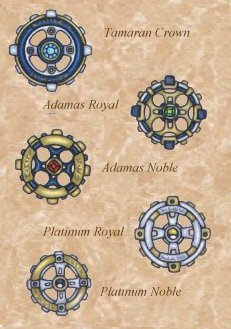
Tamaran Crown (Adamas, Diamond):
Adamas Royal (Adamas, Emerald):
Adamas Noble (Adamas, Gold, Ruby):
Platinum Royal (Platinum, Topaz):
Platinum Noble (Gold, Platinum, Onyx):
|
|
1000 Coin
500 Coin
100 Coin
50 Coin
10 Coin
These coins are actually common, uniform Machine components that have been modified, plated, and gem-inlaid. The most valuable of these are the rare Tamaran crowns, which are used almost exclusively by the gorgish banks. Only the most foolhardy or well-guarded individual would carry around even a single one of these coins in public. Other than gorg banks, the only place one is likely to see these coins is in a Tamaran casino, or a dragon's hoarde. Below this lofty piece, the adamas royal and noble, which still represent large quantities, but find a more common use in the upper-class markets. They are generally used to purchase slaves, or used as betting chips in arenas and casinos alike. They are also popular for bribes. The less-valuable platinum royal and noble are the coin of the 'common' folk, used to pay for the outrageous day-to-day expenses of Tamaran life. These include meals, beauty treaments, arena tickets, and so forth. Particularly wealthy citizens will even use these coins to tip.
The most significant feature of these coins, however, is a secret one. The gorgs paid the Arcanar guild to equip one coin in ten with runes that would allow for easy location through magical means. Whenever a significant quantity of coins is stolen or lost, it can be located, for a price, by the Arcanar wizards. They even employ a special division of investigators for just this purpose.
HACKMETAL (Skolish Currency)
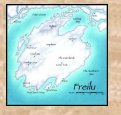 After the fall of the Solinar kingdom, the skoles returned to their nomadic ways, and took with them the concept of an economy based on precious metals instead of raw goods. Rather than adopting abstract coins, however, the lupines established a more informal exchange system - the use of hackmetal. These are generally pieces of plain gold or silver jerwelery worn about the arms and neck, to be traded, broken, or sliced into portions (hence 'hackmetal') in order to pay for goods and services. The metal is soft and easy to re-forge, and bracelets are commonly available, paid out to skolish workers from a tribal fund controlled by the smiths. The wealth is largely transitory - most skoles would much rather have excellent weapons, good drink, and barely enough left over to get them through lean times. Hoarding money is pointless, as it tends to weigh down the hoarder.
After the fall of the Solinar kingdom, the skoles returned to their nomadic ways, and took with them the concept of an economy based on precious metals instead of raw goods. Rather than adopting abstract coins, however, the lupines established a more informal exchange system - the use of hackmetal. These are generally pieces of plain gold or silver jerwelery worn about the arms and neck, to be traded, broken, or sliced into portions (hence 'hackmetal') in order to pay for goods and services. The metal is soft and easy to re-forge, and bracelets are commonly available, paid out to skolish workers from a tribal fund controlled by the smiths. The wealth is largely transitory - most skoles would much rather have excellent weapons, good drink, and barely enough left over to get them through lean times. Hoarding money is pointless, as it tends to weigh down the hoarder.
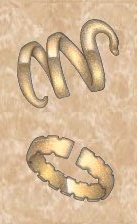 Hackmetal is easy to bend and thus conforms to almost any wearer. The weight of the metal is insignificant to the big canines, though smaller wearers will no doubt find them cumbersome. Also, in spite of the fact that there is little thievery among the members of skole tribes, the bracelets, torcs, and headpieces are quite difficult to steal without the owner noticing. Even the bravest thieves are often reluctant to jump these huge canines. Furthermore, a considerable strength and quality blade are required to slice off segments of hackmetal, at least without risking one's fingers or taking an embrassingly long time at the counter.
Hackmetal is easy to bend and thus conforms to almost any wearer. The weight of the metal is insignificant to the big canines, though smaller wearers will no doubt find them cumbersome. Also, in spite of the fact that there is little thievery among the members of skole tribes, the bracelets, torcs, and headpieces are quite difficult to steal without the owner noticing. Even the bravest thieves are often reluctant to jump these huge canines. Furthermore, a considerable strength and quality blade are required to slice off segments of hackmetal, at least without risking one's fingers or taking an embrassingly long time at the counter.
There is no default currency set for hackmetal. It is generally simple enough to be made by even inexperienced smiths, who take salvaged gold and even coins from other realms, re-shaping them into a wealth that is easier to handle (in their opinion). Most smiths will trade gold by weight, and exchange hackmetal for items and coinage of equal value. As a rule of thumb, most gold bracelets are worth 10 coin, torcs 20, and necklaces 30. Similar values exist for silver variants, which are more common. Hackmetal is commonly accepted throughout Freilu, Arthandur, and some parts of Arcada, and is frowned upon by the more 'civilized' cultures, in spite of its raw value. It's generally seen as the currency of barbarians.
GEMSTONES (Gorgish Trade Currency)
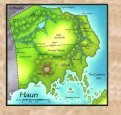
Gemstones have a certain universal appeal, even if it's just their sparkle. Their rarity and color also plays a part in determining the value of individual stones - some are merely ornamental, while others could only belong in the most splenderous of settings. When carefully cut, ground, and polished, they can be made even more valuable and pleasing to the eye. The simplest of these is the cabochon style, which is generally used by the more primitive crafters to shape semiprecious and ornamental stones into beads. This style is also used to set gems into the pommels of swords and daggers. The more complex cuts, such as the table and pear style tend to increase a gemstone's brilliance by catching light and trapping it within. Gemstones are also known to contain magical potential, and are easily enchanted. Countless varieties exist, both individual and hybrid.

Wealthy merchants often convert portions of their holdings into gemstones, making them a form of higher currency. Indeed, gorgs will often spend hours trading gemstones, before even getting down to business. This is a form of religious ritual, which helps each merchant determine the personality and aggressiveness of their rivals. The lutrai, on the other hand, prize gemstones for little more than their bright color and reflectiveness. These are generally uncut, worn around the neck on a leather cord or set into shamanic talismans. The skoles use the harder stones to edge their great war blades, and the Arcanar guild requires a constant supply of stones in order to perform a variety of magical rituals.
The gems most well-known for their magical potential are listed below, though there are countless other varieties, many of which remain undiscovered. When employed as spell components, they dissolve into the effect itself, often rendering it more powerful. In order to employ gemstones in this way, the stone must have a number of carats that are at least equal to the spell being cast. This is in addition to any of the normal components associated with casting the spell in question. Once used, a gemstone is impossible to recover, literally disintigrating into nothingness. Powerful sorcerors will often decorate their clothing with gemstones that pertain to their school or focus, though few are foolhardy enough to walk openly in such splendor. Uncut gems, which often contain flaws and inclusions, cannot be used to purify magic in this way. Some lesser gemstones, by contrast, are capable of holding minor spells until needed, though these are far more limited in nature and do not depend as heavily on quality (minimum 50 coin value).
|
Average Cost
Diamond: 1d6x1000 Coin (500/carat)
Ruby: 1d4x1000 Coin (400/carat)
Sapphire: 1d4x1000 Coin (400/carat)
Emerald: 1d4x1000 Coin (400/carat)
Opal: 1d6x500 Coin (250/carat)
Pearl: 1d4x100 Coin (40/carat)
Garnet: 1d4x100 Coin (40/carat)
Aquamarine: 1d6x100 Coin (50/carat)
Topaz: 1d6x100 Coin (50/carat)
Jet: 1d4x100 Coin (40/carat)
Amethyst: 1d6x10 Coin
Peridot: 1d6x10 Coin
Turquoise: 1d4x10 Coin
Jade: 1d4x10 Coin
Onyx: 1d4x10 Coin
|
|
Properties
Maximizes summoned air elementals or electrical spells.
Maximizes summoned fire elementals or fire spells.
Maximizes summoned water elementals or cold spells.
Maximizes summoned earth elementals or force spells .
Maximizes healing or holy spells.
Empowers electrical spells.
Empowers fire spells.
Empowers cold spells.
Empowers force spells.
Empowers negative energy spells.
Can hold Cure Disease until swallowed.
Can hold Daylight until polished.
Can hold Water Walk until immersed.
Can hold Delay Poison until swallowed.
Can hold Darkness until polished.
 OFF-PLANAR ACCOUNT
(Money Storage)
OFF-PLANAR ACCOUNT
(Money Storage)
Rather than carrying around their vast fortunes, or storing them in places that might be burglarized (or taxed), the gorgs have developed the concept of off-planar banking. Scattered throughout the near-infinite reaches of the astral plane, gorg vaults represent the ultimate in anti-theft countermeasures. Constructed in Tamara, the vaults are heavily enchanted by the Arcanar guild, with varying levels of security ranging from alarms, to blast glyphs, to golems. Gated to the astral plane, they are then magically tethered to a specific rune card and leased out to anyone willing to open a large enough account (and often offered as incentive to do so). These account cards allow only a specified number of people, whose names appear on the card, to access the otherwise unreachable vault. In order to enter the vault to retrieve or deposit money and items, the card-holder must visit a bank or mercantile outlet and make use of a Vault Gate. This runic portal reacts with the account card and instantly transports the holder to a corresponding portal within the astral vault.
Low Security (Bronze Package): The vault contains a small artifact gallery and cache for coins, but no additional locks. The structure is unguarded, but is password protected by a Forbiddance spell that bars anyone not of the account member's alignment (in joint accounts, all additional signees must know the password). Furthermore, the chache itself is protected by a permanent Alarm spell, which automatically alerts the primary card holder whenever it's opened. This service costs 100 Coin per month, with an additional 10 Coin charge for each visit. Interest is 3% annual.
High Security (Gold Package): The cache is protected by a Symbol of Death (DC 24), which is triggered by anyone whose name isn't inscribed on the card. The gallery is also patrolled by an elegantly carved white marble golem, which will brutally attack and kill anyone not on the account. The cache contains a counting machine, and is locked by an equally complex mechanism. A permanent Ghost Sound spell creates a repeating loop of serene music in the gallery area. There are, additionally, up to four permanent Magic Mouth spells to boast about the various artifacts that may be found there. This service costs 500 Coin per month, though all visiting fees are waived. Interest is 4.5% annual.
Back...
 Erdani coins are second only to Tamaran gears in artistic design, and for good reason. The gorgs who mint them have discovered that by creating currency that is highly pleasing to the eye, they increase the lengths to which people will go to get it. Ordinary gold may glitter, but when mixed with certain patterns of jewels and fine etching, coins become even more coveted. This mild greed-enhancement drives up the economy, giving it a much stronger hold over society than within non-plutocratic systems. The gorgs are also very traditional in their currency design - unusual shapes and colors aside, they insist that the value of each coin be self-backing, and thus universally appealing to those who might not otherwise recognize the coin of other realms. They are surprisingly durable and nearly impossible to counterfeit, the product of a culture obsessed with the sacred qualities of wealth and materialism. The triangular shape is designed for efficient stacking - coins of similar value can be stacked end-to-end into a container such as a chest with no wasted space whatsoever. It also keeps them from rolling away when spilled, and makes coin-shaving blatantly obvious.
Erdani coins are second only to Tamaran gears in artistic design, and for good reason. The gorgs who mint them have discovered that by creating currency that is highly pleasing to the eye, they increase the lengths to which people will go to get it. Ordinary gold may glitter, but when mixed with certain patterns of jewels and fine etching, coins become even more coveted. This mild greed-enhancement drives up the economy, giving it a much stronger hold over society than within non-plutocratic systems. The gorgs are also very traditional in their currency design - unusual shapes and colors aside, they insist that the value of each coin be self-backing, and thus universally appealing to those who might not otherwise recognize the coin of other realms. They are surprisingly durable and nearly impossible to counterfeit, the product of a culture obsessed with the sacred qualities of wealth and materialism. The triangular shape is designed for efficient stacking - coins of similar value can be stacked end-to-end into a container such as a chest with no wasted space whatsoever. It also keeps them from rolling away when spilled, and makes coin-shaving blatantly obvious.

 Erdani coins are second only to Tamaran gears in artistic design, and for good reason. The gorgs who mint them have discovered that by creating currency that is highly pleasing to the eye, they increase the lengths to which people will go to get it. Ordinary gold may glitter, but when mixed with certain patterns of jewels and fine etching, coins become even more coveted. This mild greed-enhancement drives up the economy, giving it a much stronger hold over society than within non-plutocratic systems. The gorgs are also very traditional in their currency design - unusual shapes and colors aside, they insist that the value of each coin be self-backing, and thus universally appealing to those who might not otherwise recognize the coin of other realms. They are surprisingly durable and nearly impossible to counterfeit, the product of a culture obsessed with the sacred qualities of wealth and materialism. The triangular shape is designed for efficient stacking - coins of similar value can be stacked end-to-end into a container such as a chest with no wasted space whatsoever. It also keeps them from rolling away when spilled, and makes coin-shaving blatantly obvious.
Erdani coins are second only to Tamaran gears in artistic design, and for good reason. The gorgs who mint them have discovered that by creating currency that is highly pleasing to the eye, they increase the lengths to which people will go to get it. Ordinary gold may glitter, but when mixed with certain patterns of jewels and fine etching, coins become even more coveted. This mild greed-enhancement drives up the economy, giving it a much stronger hold over society than within non-plutocratic systems. The gorgs are also very traditional in their currency design - unusual shapes and colors aside, they insist that the value of each coin be self-backing, and thus universally appealing to those who might not otherwise recognize the coin of other realms. They are surprisingly durable and nearly impossible to counterfeit, the product of a culture obsessed with the sacred qualities of wealth and materialism. The triangular shape is designed for efficient stacking - coins of similar value can be stacked end-to-end into a container such as a chest with no wasted space whatsoever. It also keeps them from rolling away when spilled, and makes coin-shaving blatantly obvious.

 It's important to mention here that prices are a little steep in Tamara. After all, it's a place where dreams are bought for gold. For larger transactions, it became aparent that wheeling a cart full of money down the street wasn't safe, and people didn't want to carry bags of platinum to cover the outrageous day to day expenses. To solve this problem, the Decider commissioned the gorg merchant leagues to create a set of higher-value coins, which actually look more like uniform items of extremely durable jewelery. These coins are shown below, along with their values. Like any good coin, these are actually worth the sum of their materials, and are most commonly found within the casinos much like chips (they stack well). The introduction of this special series of coins made larger purchases easier. On the other hand, the number of pickpockets went up nearly threefold.
It's important to mention here that prices are a little steep in Tamara. After all, it's a place where dreams are bought for gold. For larger transactions, it became aparent that wheeling a cart full of money down the street wasn't safe, and people didn't want to carry bags of platinum to cover the outrageous day to day expenses. To solve this problem, the Decider commissioned the gorg merchant leagues to create a set of higher-value coins, which actually look more like uniform items of extremely durable jewelery. These coins are shown below, along with their values. Like any good coin, these are actually worth the sum of their materials, and are most commonly found within the casinos much like chips (they stack well). The introduction of this special series of coins made larger purchases easier. On the other hand, the number of pickpockets went up nearly threefold.

 After the fall of the Solinar kingdom, the skoles returned to their nomadic ways, and took with them the concept of an economy based on precious metals instead of raw goods. Rather than adopting abstract coins, however, the lupines established a more informal exchange system - the use of hackmetal. These are generally pieces of plain gold or silver jerwelery worn about the arms and neck, to be traded, broken, or sliced into portions (hence 'hackmetal') in order to pay for goods and services. The metal is soft and easy to re-forge, and bracelets are commonly available, paid out to skolish workers from a tribal fund controlled by the smiths. The wealth is largely transitory - most skoles would much rather have excellent weapons, good drink, and barely enough left over to get them through lean times. Hoarding money is pointless, as it tends to weigh down the hoarder.
After the fall of the Solinar kingdom, the skoles returned to their nomadic ways, and took with them the concept of an economy based on precious metals instead of raw goods. Rather than adopting abstract coins, however, the lupines established a more informal exchange system - the use of hackmetal. These are generally pieces of plain gold or silver jerwelery worn about the arms and neck, to be traded, broken, or sliced into portions (hence 'hackmetal') in order to pay for goods and services. The metal is soft and easy to re-forge, and bracelets are commonly available, paid out to skolish workers from a tribal fund controlled by the smiths. The wealth is largely transitory - most skoles would much rather have excellent weapons, good drink, and barely enough left over to get them through lean times. Hoarding money is pointless, as it tends to weigh down the hoarder.
 Hackmetal is easy to bend and thus conforms to almost any wearer. The weight of the metal is insignificant to the big canines, though smaller wearers will no doubt find them cumbersome. Also, in spite of the fact that there is little thievery among the members of skole tribes, the bracelets, torcs, and headpieces are quite difficult to steal without the owner noticing. Even the bravest thieves are often reluctant to jump these huge canines. Furthermore, a considerable strength and quality blade are required to slice off segments of hackmetal, at least without risking one's fingers or taking an embrassingly long time at the counter.
Hackmetal is easy to bend and thus conforms to almost any wearer. The weight of the metal is insignificant to the big canines, though smaller wearers will no doubt find them cumbersome. Also, in spite of the fact that there is little thievery among the members of skole tribes, the bracelets, torcs, and headpieces are quite difficult to steal without the owner noticing. Even the bravest thieves are often reluctant to jump these huge canines. Furthermore, a considerable strength and quality blade are required to slice off segments of hackmetal, at least without risking one's fingers or taking an embrassingly long time at the counter.


 OFF-PLANAR ACCOUNT
(Money Storage)
OFF-PLANAR ACCOUNT
(Money Storage)